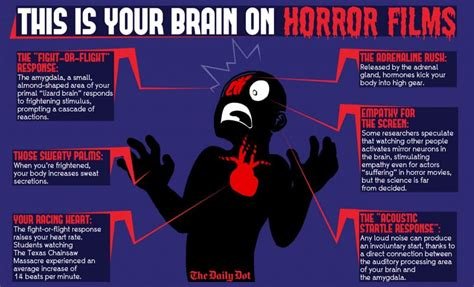The Psychological Effects of Watching Horror Movies
Are you a horror movie enthusiast, or do you avoid them at all costs? Regardless of your preference, it’s no secret that horror movies have evolved significantly over the years. But have you ever wondered about the psychological effects of watching these spine-chilling films? In this blog post, we’ll delve into the fascinating world of horror movies and their impact on our minds. From the evolution of horror movies to the science behind fear, we’ll explore how these films affect our brains and emotions. We’ll also uncover the connection between fear conditioning and desensitization, as well as the potential for nightmares and sleep disturbances. Additionally, we’ll discuss the adrenaline rush and stress response that comes with watching horror movies, as well as the concept of catharsis and emotional release. So sit back, grab your popcorn, and prepare to uncover the psychological effects of indulging in a good horror flick.
The Evolution of Horror Movies
Horror movies have come a long way since their inception in the early 20th century. The evolution of horror movies can be traced back to the silent film era, with classics like The Cabinet of Dr. Caligari and Nosferatu setting the stage for the genre. These early films relied on eerie atmosphere and gothic imagery to evoke fear in the audience.
As technology advanced, horror movies underwent a transformation, with the introduction of sound and special effects. This allowed directors to create more immersive and terrifying experiences for viewers. The 1970s and 80s saw the rise of slasher films like Halloween and Friday the 13th, which became synonymous with the horror genre.
In recent years, there has been a shift towards more psychological horror, with films like Hereditary and The Babadook focusing on the psychological impact of fear. These films delve into the deep-seated anxieties and traumas of the human psyche, offering a more cerebral approach to horror storytelling.
The evolution of horror movies reflects the ever-changing fears and anxieties of society, as well as advancements in filmmaking technology. From silent classics to modern psychological thrillers, the genre continues to evolve and captivate audiences with its ability to tap into our deepest fears.
The Science Behind Fear
Fear is a powerful and primal emotion that has intrigued researchers for centuries. The science behind fear delves into the intricacies of the human brain and the physiological responses that occur when we encounter a frightening stimulus. It involves a complex interplay of neurotransmitters, hormones, and neural pathways that can be both fascinating and terrifying to explore.
One of the key components of the science behind fear is the amygdala, an almond-shaped structure in the brain that is responsible for processing emotions, including fear. When we perceive a threat, the amygdala sends a distress signal to the hypothalamus, which triggers the release of adrenaline and other stress hormones. This sets off a series of physiological changes in the body, such as increased heart rate, rapid breathing, and heightened sensory perception, all of which are designed to prepare us to either fight or flee from the danger.
Furthermore, the science behind fear also involves the prefrontal cortex, the part of the brain responsible for decision-making and rational thought. It plays a crucial role in evaluating the level of threat and determining the appropriate response. Additionally, the hippocampus, which is involved in memory formation, helps to store and retrieve information about past frightening experiences, allowing us to learn from them and avoid similar situations in the future.
Understanding the science behind fear not only provides valuable insights into our physiological and psychological responses to fear, but also offers potential applications in fields such as psychology, psychiatry, and even entertainment, as it can help us better comprehend and manage our fears, as well as develop more effective treatments for anxiety-related disorders.
Psychological Impact on the Brain
When it comes to the psychological impact on the brain, fear is a powerful emotion that can have a profound effect on our mental wellbeing. The experience of fear triggers a cascade of neurological responses that can actually alter the structure and function of the brain over time. This can lead to changes in behavior, cognition, and emotional regulation.
Fear activates the amygdala, an almond-shaped cluster of nuclei located deep within the brain. The amygdala is responsible for processing emotions, particularly those related to fear and threat. When we encounter something frightening, the amygdala initiates a rapid, automatic response that prepares the body to either fight or flee. This includes releasing stress hormones like adrenaline and cortisol, which can have a range of effects on the body and brain.
Chronic exposure to fear and stress can also lead to long-term changes in the brain. Prolonged activation of the stress response can cause the hippocampus, a brain region involved in memory and learning, to shrink in size. This can impair the ability to form new memories and regulate emotions, leading to symptoms of anxiety and depression.
Furthermore, fear can also influence the neurochemistry of the brain. The release of neurotransmitters like dopamine, serotonin, and norepinephrine can shape our perceptions, mood, and even our ability to experience pleasure. This intricate interplay between fear and the brain highlights the profound psychological impact that fear can have on our mental health and emotional well-being.
Fear Conditioning and Desensitization
Fear conditioning, also known as associative learning, is a psychological process in which an individual becomes fearful of a particular stimulus after associating it with a negative experience. This is often seen in horror movies, where viewers are conditioned to fear certain objects, locations, or scenarios due to their association with danger or harm.
Desensitization, on the other hand, is the process of reducing an individual’s sensitivity or responsiveness to a particular stimulus. This can be achieved through repeated exposure to the fear-inducing stimulus in a safe and controlled environment. In the context of horror movies, desensitization can occur when individuals expose themselves to frightening scenes or imagery, gradually reducing their fear response over time.
Psychologists often use fear conditioning and desensitization techniques to help individuals overcome phobias and anxieties. By gradually exposing individuals to their fears in a controlled setting, they can learn to reassociate the frightening stimulus with a more neutral or positive response, ultimately reducing their fear and anxiety levels.
It’s important to note that fear conditioning and desensitization can have both positive and negative implications. While they can be effective tools for overcoming fears and anxieties, they can also desensitize individuals to real-life dangers and contribute to a desensitization of violence and horror in media and entertainment.
Nightmares and Sleep Disturbances
Do you ever wake up in the middle of the night, drenched in sweat, heart racing, and feeling terrified by a vivid nightmare that seemed all too real? Nightmares are unsettling and can have a significant impact on our sleep quality and overall well-being. These distressing dreams can disrupt our sleep, leaving us feeling exhausted and anxious the next day.
For many people, nightmares are an occasional occurrence, often linked to stress, anxiety, or traumatic experiences. However, for some individuals, nightmares can be a chronic and debilitating issue, leading to sleep disturbances and even psychological disorders.
Research suggests that nightmares are often a manifestation of our deepest fears and unresolved emotional trauma. The content of our nightmares can reflect our subconscious anxieties and struggles, making them a valuable window into our emotional and psychological state.
Understanding the causes and effects of nightmares is crucial in addressing sleep disturbances and promoting mental well-being. By exploring the science behind nightmares and the impact they have on our sleep quality, we can gain insight into the complex relationship between our minds and our dreams.
Adrenaline Rush and Stress Response
Have you ever found yourself in a situation where your heart starts racing, your palms get sweaty, and your senses are heightened? This is the classic adrenaline rush that many people experience in response to a perceived threat or danger. When your body senses an imminent danger, it releases the hormone adrenaline, which prepares you to either fight the threat or flee from it, also known as the fight or flight response.
This physiological response is actually a complex process involving various systems in the body, including the nervous system and the endocrine system. Once your brain perceives a threat, it sends signals to the adrenal glands, which then release adrenaline into the bloodstream. This surge of adrenaline leads to several bodily changes, such as increased heart rate, elevated blood pressure, and improved oxygen flow to the muscles, all of which are essential for dealing with the threat at hand.
While an adrenaline rush can be beneficial in certain situations, such as escaping from immediate danger, it can also have negative effects if experienced chronically. Prolonged exposure to stress and repeated adrenaline rushes can lead to physical and mental health issues, including anxiety, insomnia, and even cardiovascular problems. It’s important to manage stress and find healthy ways to cope with the adrenaline rush to prevent long-term health concerns.
So, while an adrenaline rush can be a natural and necessary response to danger, it’s crucial to understand its effects on the body and mind and take steps to manage stress effectively. Finding ways to reduce stress and promote relaxation can help prevent the negative impact of chronic adrenaline rushes and maintain overall well-being.
Catharsis and Emotional Release
When it comes to dealing with intense emotions, finding a sense of catharsis and emotional release can be crucial for our mental well-being. Whether it’s through creative outlets such as art or music, physical activities like exercise, or simply talking it out with a trusted friend or therapist, finding healthy ways to process and release our emotions is essential.
Engaging in activities that allow for emotional expression can help to alleviate feelings of stress and anxiety, and promote a sense of inner peace and clarity. Creativity, in particular, has been shown to have a powerful effect on our emotional well-being, offering a means of catharsis that allows us to channel our emotions into something positive and constructive.
Furthermore, finding ways to release pent-up emotions can prevent them from turning into chronic stress, which can have detrimental effects on both our mental and physical health. By actively seeking out opportunities for catharsis and emotional release, we can protect ourselves from the harmful impact of unresolved emotional turmoil.
In conclusion, prioritizing moments of catharsis and emotional release in our daily lives is essential for maintaining a healthy emotional balance. Whether it’s through engaging in creative activities, physical exercise, or seeking support from others, finding healthy outlets for processing and releasing our emotions can have a profound impact on our overall well-being.
Frequently Asked Questions
What is the Evolution of Horror Movies?
The Evolution of Horror Movies explores the history and development of the horror genre in cinema, from its early beginnings to modern-day trends.
What is the Science Behind Fear?
The Science Behind Fear delves into the psychological and physiological aspects of fear, including how the brain processes fear-inducing stimuli and the body’s fight-or-flight response.
What are the Psychological Impacts on the Brain?
Psychological Impact on the Brain examines the lasting effects that exposure to horror movies can have on the human brain, such as heightened anxiety and hypervigilance.
How does Fear Conditioning and Desensitization work?
Fear Conditioning and Desensitization delves into the process of becoming desensitized to fear through repeated exposure, as well as the potential long-term consequences of desensitization.
Can Horror Movies Cause Nightmares and Sleep Disturbances?
Nightmares and Sleep Disturbances discusses the possible correlation between watching horror movies and experiencing nightmares, as well as disruptions in regular sleep patterns.
What is the Relationship between Adrenaline Rush and Stress Response?
Adrenaline Rush and Stress Response explores the body’s physiological reactions to fear-inducing stimuli, including the release of adrenaline and the accompanying stress response.
How does Catharsis and Emotional Release relate to Horror Movies?
Catharsis and Emotional Release examines the concept of using horror movies as a means of emotional release and discusses the potential psychological benefits of catharsis.





